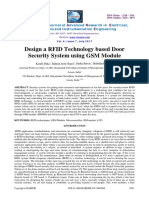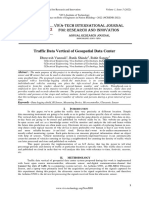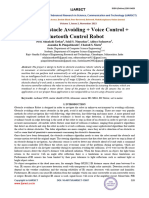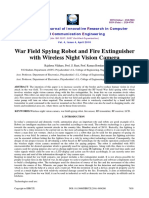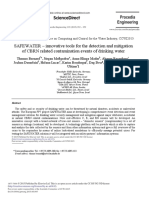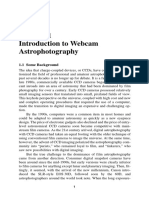RFID and GSM Based School Bus Tracking System
RFID and GSM Based School Bus Tracking System
Uploaded by
deviselva75Copyright:
Available Formats
RFID and GSM Based School Bus Tracking System
RFID and GSM Based School Bus Tracking System
Uploaded by
deviselva75Original Title
Copyright
Available Formats
Share this document
Did you find this document useful?
Is this content inappropriate?
Copyright:
Available Formats
RFID and GSM Based School Bus Tracking System
RFID and GSM Based School Bus Tracking System
Uploaded by
deviselva75Copyright:
Available Formats
ISSN(Online): 2320-9801
ISSN (Print): 2320-9798
International Journal of Innovative Research in Computer
and Communication Engineering
(An ISO 3297: 2007 Certified Organization)
Website: www.ijircce.com
Vol. 5, Issue 2, February 2017
RFID and GSM Based School Bus Tracking
System
S.N.L Priyanka1, D.Srirama Murthy2, K.Vamsi Krishna3, M.Sharmila Rani4, T.S.S.K.Mohan5, M.Kishore6
Students, Department of Electronics and Communication Engineering, DMS SVH College of Engineering, Andhra
Pradesh, India. 1,3,4,5,6
Associate Professor, Department of Electronics and Communication Engineering, DMS SVH College of Engineering,
Andhra Pradesh, India. 2
ABSTRACT: Now-a-days with the increase in the crime rate and accidents parents have worry about their children
when they are going to schools. To get rid of this fear they need some systems to know the status of their children, this
paper is one of that kind. It has two units BUS UNIT and SCHOOL UNIT. BUS UNIT consists of RFID Reader,
different sensors and GSM module to issue the alert messages to parents when their children boards or leaves the bus.
Temperature sensor, gas sensor, accelerated tilt sensor will be placed within the bus unit to detect fire, gases and tilting
of bus and issues alert messages by giving the location of the bus using GSM and GPS modules. SCHOOL UNIT
consists of RFID Reader and GSM Module. The entire data in two units will be processed by using ARDUINO UNO
ATMEGA 328 Processor.
KEYWORDS: RFID; GSM module; GPS module; ARDUINO UNO, Sensors.
I. INTRODUCTION
At present days all are very much aware about the safety concerns. At the same time parents can admit their
children in schools which have high reputation and all facilities. Now-a-days all schools have bus facilities, even
though their child are going to school through school bus parents have some worry about their child, are they reached
safely or in a dangerous situation[5] (e.g. when bus met with accidents then they need help [1]). This paper gives
solution for this question.
This paper proposed a system to detect accidents using sensors like accelerated tilt, temperature, gas and smoke
sensors. This system also issues alert messages when child boards and leaves the bus using the RFID tag which was
wore by the child by placing that tag before the RFID reader [2]. These sensors and RFID reader are interfaced with
ARDUINO UNO board which has ATMEGA328 processor. The outputs of this ARDUINO UNO board are given to
GSM module and LCD display. This GSM modem can sends the messages to authorized persons according to the
received data [4]. LCD displays the message about the accidents [4]. This total system will be presents in bus, which is
called BUS UNIT.
Here a SCHOOL UNIT is also there which have ARDUINO board, RFID Reader and GSM Modem. This unit will
issues the messages to parents to con-vey them that their children are reached the school safely, and they are in the
school premises.
II. LITERATURE SURVEY
Our project idea is to put an end to incidents like Innocent children are ending their lives for unworthy reasons [1].
There are many systems which provide security to the school children. The use of RFIDs makes it easier to maintain
and usage, but could not give the certain formation about the situation in the bus i.e.…this system is it does not provide
any information when children are in dangerous situations [2]. To track the live location of the bus for the speedy
recovery when it is subjected to accidents[3].To intimate the school management and parents about the hazardous
Copyright to IJIRCCE DOI: 10.15680/IJIRCCE.2017. 0502063 2409
ISSN(Online): 2320-9801
ISSN (Print): 2320-9798
International Journal of Innovative Research in Computer
and Communication Engineering
(An ISO 3297: 2007 Certified Organization)
Website: www.ijircce.com
Vol. 5, Issue 2, February 2017
situation in the bus[4].to avoid the rash driving and to intimate when the bus is subjected to tilt Our paper devised a
method to identify the students are dropped at correct locations and if they are dropped elsewhere the location is
identified and alert is sent to parent. [5].
III. PROPOSED SYSTEM OVERVIEW
A. BLOCK DIAGRAM
.
Fig 1. Block diagram overview of the system
Figure1 clearly explains the whole proposed system. The main component is the ARDUINO ATME-GA328
processor, all the sensors and the RFID reader, GPS module are given as the inputs to the processor. The processed data
will be displayed on LCD display [4] to convey to the driver about the situation, and this processed data will also be
conveyed to authorized persons through GSM modem. Now the clear description of the components in the system are
given below clearly
Fig 2. ARDUINO UNO board
The Arduino Uno is a microcontroller board based on the ATmega328. It has 14 digital input/output pins (of which
6 can be used as PWM outputs), 6 analog inputs, a 16 MHz crystal oscillator, a USB connection, a power jack, an ICSP
header, and a reset button. It contains everything needed to sup-port the microcontroller; simply connect it to a
computer with a USB cable or power it with a AC-to-DC adapter or battery to get started. The Uno differs from all
preceding boards in that it does not use the FTDI USB-to-serial driver chip. Instead, it features the Atmega8U2
programmed as a USB-to-serial converter.
Copyright to IJIRCCE DOI: 10.15680/IJIRCCE.2017. 0502063 2410
ISSN(Online): 2320-9801
ISSN (Print): 2320-9798
International Journal of Innovative Research in Computer
and Communication Engineering
(An ISO 3297: 2007 Certified Organization)
Website: www.ijircce.com
Vol. 5, Issue 2, February 2017
B. RFID TAG
There are two types of RFID tags. They are passive tags and active tags. Active tags have battery and continuously
broadcast their own signal, they pro-vide much longer read range than passive tags [4]. Passive tags didn’t have internal
power source, they energized by the electromagnetic energy transmitted from an RFID reader.
Below figure gives the inside view of the passive tag. A passive tag has an antenna and a chip. Tag antenna receives
signal from reader and powers the chip, this signal can be modified according to the unique information present in the
chip and retransmitted through antenna.
Fig 3. RFID Tag.
For this system passive tag is the correct one be-cause they have short reading range which fit to our requirement to
detect the child when he/she close to the reader.
Fig 4. RFID Reader and Tag.
The above figure shows how RFID reader and tag can ex-change the information.
C. RFID READER
There are three types of RFID readers based on their frequency ranges, low frequency, high frequency and ultra-
high frequency.
This EM-18 is a low frequency (125 KHz) RFID reader with serial output with at range of 8-12cm. It is a compact
unit with built in antenna and can be directly connected to the PC using RS232 protocol [4]. It is an inexpensive
solution for this RFID based application. The Reader module comes with an on-chip antenna and can be powered up
with a 5V power supply.
D. ACCELERATED TILT SENSOR
The ADXL330 is a small, thin, low power, complete 3-axis accelerometer with signal conditioned voltage outputs,
all on a single monolithic IC. It can measure the static acceleration of gravity in tilt-sensing applications, as well as
dynamic acceleration resulting from motion, shock, or vibration. This sensor is interfaced with ARDUINO UNO board.
The sensed data will be processed by the Atmega 328 processor and is transmitted to authorized persons using Global
System for Mobile communication (GSM).
Copyright to IJIRCCE DOI: 10.15680/IJIRCCE.2017. 0502063 2411
ISSN(Online): 2320-9801
ISSN (Print): 2320-9798
International Journal of Innovative Research in Computer
and Communication Engineering
(An ISO 3297: 2007 Certified Organization)
Website: www.ijircce.com
Vol. 5, Issue 2, February 2017
E. GAS SENSOR
MQ6 is the gas sensor which suits to this requirement. It has high sensitivity to Propane, Butane and LPG and it
also respond to Natural gas. This sensor is interfaced with Atmega 328 processor and sensed information will be
transmitted to respected persons through GSM.
F. TEMPERATURE SENSOR
The LM35 is a temperature device with an output voltage linearly proportional to the Centigrade temperature. The
operating voltage is from 4V to 30V, range of this device is from −55°C to 150°C. Accuracy of this is about 0.5°C. It
has three pins 1st pin is power supply pin, 2nd pin is output pin which is connected to arduino board, and 3rd pin is the
ground pin.
G. GSM (GLOBAL SYSTEM FOR MOBILE COMMUNICATIONS)
GSM was developed by the European Telecommunications Standards Institute (ETSI) which de-scribes the
protocols for 2G cellular networks used in mobile phones. It is operating over 219 countries and territories. GSM is
implemented using narrow band time division multiple access (TDMA) and is used in various digital wireless
telephony technologies. The data is digitized, compressed and sent through a channel (which may have other users)
during its time slot. The frequency band is 900MHz or 1800MHz. As the GSM operators are globally agreed upon, they
allow the users to use their same mobile phone in different countries by changing the SIM card [3].
H. GPS (GLOBAL POSITIONING SYSTEM)
The boarding and de-boarding location of the students are identified using GPS technology. The GPS coordinates
are captured and the GSM modem sends it to the parent and the authorities. GPS is a satellite navigation system which
gathers accurate information regarding to the location and time. If there is no obstruction of sight between three or
more GPS satellites on or near the Earth, the location can be accurately determined. 24 satellites are currently active in
the GPS navigation system. Along with these satellites and ground stations, the GPS receiver calculates the location of
the students [3].
IV. HARDWARE IMPLEMENTATION
Fig.5 shows the hardware implementation of the bus unit. Here GPS, GSM modules and RFID Redaer and sensors
are interfaced to the ARDUINO board. Accelerated tilt sensor and gas sensor detects the tilting of the bus and entering
gases into the bus respectively and sends this information to the arduino board. This arduino board process this received
information from the inputs and gives necessary instructions to output that are GSM Module and LCD Display.
Fig 5. Hardware Connections.
Copyright to IJIRCCE DOI: 10.15680/IJIRCCE.2017. 0502063 2412
ISSN(Online): 2320-9801
ISSN (Print): 2320-9798
International Journal of Innovative Research in Computer
and Communication Engineering
(An ISO 3297: 2007 Certified Organization)
Website: www.ijircce.com
Vol. 5, Issue 2, February 2017
But in this fig.5 LCD Display is not yet interfaced to the arduino board. But the RFID part is completed.
So,Whenever the Tag is placed near the Reader a beep sound is heard simultaneously a green LED will glow. This
indicates that the information from the tag is received by the reader. Then a message will be issued to parents
conveying that your child entered safely into the bus, your child departed safely from the bus.
V. RESULTS
These are some of the results that are obtained, whenever child board and leave the bus and also conveying about
the accidents like fire by observing the changes in the temperature sensor.
Fig 6. Alert Messages.
The fig.6 shows the result of issuing the message alert when the children boards and departed from the bus in which
the present situation is mentioned and message is issued by the GSM modem. Whenever the child brings his RFID Tag
near to the RFID Reader then the information of tag is read by the reader and this is conveyed to arduino board. This
arduino board sends some instruction to GSM Modem, according to that an alert message will be issued to authorized
persons and school authorities.
Fig 7. Message from GSM Modem.
The fig.7 shows the result, when fire is detected in the bus with immediate action it is detected by the temperature
sensor, and a message will be issued by the GSM modem, which is present in the given figure below. The temperature
sensor is useful to sense the changes in the temperature and gives the information to arduino board, from this
information will be conveyed to authorized persons through GSM Modem.
Copyright to IJIRCCE DOI: 10.15680/IJIRCCE.2017. 0502063 2413
ISSN(Online): 2320-9801
ISSN (Print): 2320-9798
International Journal of Innovative Research in Computer
and Communication Engineering
(An ISO 3297: 2007 Certified Organization)
Website: www.ijircce.com
Vol. 5, Issue 2, February 2017
Likewise, all sensors can sense the information and accordingly alert messages along with location will be
conveyed to the school authorities and parents with the help of GPS and GSM Modules.
VI. SYSTEM OVERVIEW
Below figure gives clear idea about this system. Whenever the child brings the RFID tag near to the RFID reader.
RFID reader will interface to ARDUINO UNO board and it transmits the alert messages saying that your child safely
reached the bus.
When the bus met with accidents like fire accident, road accidents or any gases entered into the bus. This system
provides sensors to detect these type of accidents. These sensors are interfaced to ATMEGA328 processor, this
processor issues a command to GSM modem to convey the information through message to the authorized persons
(parents of the child who are in the bus). Along with the message it sends the latitude and longitude position of the bus
to detect where the bus is. This can be achieved by using GPS module.
Fig 8. System Overview.
Copyright to IJIRCCE DOI: 10.15680/IJIRCCE.2017. 0502063 2414
ISSN(Online): 2320-9801
ISSN (Print): 2320-9798
International Journal of Innovative Research in Computer
and Communication Engineering
(An ISO 3297: 2007 Certified Organization)
Website: www.ijircce.com
Vol. 5, Issue 2, February 2017
VII. CONCLUSION
This paper presents a RFID based system that enhances the safety of the children during the daily trip from and to
school. GSM module issues messages to parents whenever the child boards and leaves the bus. Sensors in this system
senses the accidents like fire and road accidents and the total information will be convey to authorized person in the
form of message using GSM module. Location of the bus will also be detected and convey to parents with help of GPS
module. Future work includes interfacing the GPS Module to the BUS UNIT. Once this interfacing can be completed,
this system can be capable of tracing the location of the bus helping to safeguard the lives of the school children.
REFERENCES
[1] “Three students killed, 36 injured after bus falls into drain” available at:http://indianexpress.com/article/india/india-news-india/three-students-
killed-36-injured-after-bus-falls-into-drain/ [dated: 12th January 2016].
[2] Anwaar Al-Lawati, Shaikha Al-Jahdhami, Asma Al-Belushi, Dalal Al-Adawi, Medhat Awadalla and Dawood Al-Abri,” RFID-based System for
School Children Transportation Safety Enhancement”, 8th IEEE GCC Conference and Exhibition, Muscat, Oman 2015.
[3] Anusha R, Dr.R.China Appala Naidu “GPS and GSM Based School Children Tracking System” Available at International Journal of Advanced
Research in Computer Engineering and Technology, Volume 5, Issue 6, June 2016.
[4] R. Malliga.ME, T. Narmatha,”RFID-based System for School Children Transportation Safety Enhancement”, International Journal of Advanced
Research in Computer Science and Software Engineering, Volume 6, Issue 4, April 2016.
[5] 13-year-old loses arm after school bus carrying 40 turns turtle in Greater Noida. Available at:-http://indianexpress.com/article/cities/delhi/13-
year-old-loses-arm-after-school-bus-carrying-40-turns-turtle-in-greater-noida/ [Dated: May 13 2014].
[6] Nitin Shyam1 (nitinshyam109@gmail.com), Narendra Kumar2 (nkkumarnarendra27@ gmail.com),Maya Shashi3 (aj.kumar29stm@gmail.com),
Devesh Kumar4 (mit.devesh@gmail.com), “SMS Based Kids Tracking and Safety System by Using RFID and GSM”, IJISET - International Journal
of Innovative Science, Engineering & Technology, Vol. 2 Issue 5, May 2015.
[7] K. Vidyasagar, G.Balaji, K.Narendra Reddy, ”RFID-GSM imparted School children Security System”, Communications on Applied Electronics
(CAE) – ISSN : 2394-4714, Volume 2 – No.2, June 2015 – www.caeaccess.org
Copyright to IJIRCCE DOI: 10.15680/IJIRCCE.2017. 0502063 2415
You might also like
- Wireless Information Display System With Audio Using GSM and Arduino (Atmega328P-Pu)Document4 pagesWireless Information Display System With Audio Using GSM and Arduino (Atmega328P-Pu)kiran vemulaNo ratings yet
- An Iot Based Accident Prevention & Tracking System For Night DriversDocument7 pagesAn Iot Based Accident Prevention & Tracking System For Night DriversRaihanNo ratings yet
- Design and Implementation of Password Based Security Lock SystemDocument6 pagesDesign and Implementation of Password Based Security Lock SystemYashika choudharyNo ratings yet
- Smart Car Parking System Using IR SensorDocument5 pagesSmart Car Parking System Using IR SensorIJRASETPublicationsNo ratings yet
- Anti Smugg Jounral PaperDocument6 pagesAnti Smugg Jounral PaperAlexsanderNo ratings yet
- Optimized Locking and Unlocking A System Using ArduinoDocument6 pagesOptimized Locking and Unlocking A System Using ArduinoAbil Wali AkbarNo ratings yet
- Iot-Based Earthquake Warning System Development and EvaluationDocument6 pagesIot-Based Earthquake Warning System Development and EvaluationSérgio SoaresNo ratings yet
- Smart House Data Acquisition Module Basedon Pic18f4550 PDFDocument10 pagesSmart House Data Acquisition Module Basedon Pic18f4550 PDFedgardoboieroNo ratings yet
- Ijarcce 2019 81005Document11 pagesIjarcce 2019 81005Roshan RejiNo ratings yet
- 350 Detection Iee PDFDocument5 pages350 Detection Iee PDFDeepak DasNo ratings yet
- AShort RangeRadarSystemUsingArduinoDocument9 pagesAShort RangeRadarSystemUsingArduinoMahmoud SaberNo ratings yet
- 396-Article Text-720-1-10-20171230Document8 pages396-Article Text-720-1-10-20171230polianyako2000No ratings yet
- IOT Based Women's Safety Gadget: Department of ECE, Adhiyamaan College of Engineering, Hosur, Tamilnadu, IndiaDocument4 pagesIOT Based Women's Safety Gadget: Department of ECE, Adhiyamaan College of Engineering, Hosur, Tamilnadu, IndiaVijayKumar LokanadamNo ratings yet
- Smart Digital Bi-Directional Visitors Counter Based On Iot: Journal of Physics: Conference SeriesDocument8 pagesSmart Digital Bi-Directional Visitors Counter Based On Iot: Journal of Physics: Conference SeriesMaxamed YusufNo ratings yet
- Rfid BunDocument7 pagesRfid BunSimona NicoletaNo ratings yet
- Smart Watch For Elderly PersonDocument5 pagesSmart Watch For Elderly PersonIJRASETPublicationsNo ratings yet
- 40 AutomatedDocument5 pages40 AutomatedColeen TorresNo ratings yet
- Fin Irjmets1680760628Document6 pagesFin Irjmets1680760628shubheshdubeyNo ratings yet
- 46 - 7 - Design A RFID Technology Based Door Security System Using GSM ModuleDocument7 pages46 - 7 - Design A RFID Technology Based Door Security System Using GSM ModuleYasmeen HadjiNo ratings yet
- ART20202879Document3 pagesART20202879dgcgtwgnnNo ratings yet
- Smart Waste Management Using Wireless Sensor NetworkDocument5 pagesSmart Waste Management Using Wireless Sensor NetworkYaserNo ratings yet
- 84 - 15 - Result Paper - 1 - 1Document7 pages84 - 15 - Result Paper - 1 - 1Puttaraje GowdaNo ratings yet
- An Internet of Things-Based Touchless Parking System Using ESP32-CAMDocument7 pagesAn Internet of Things-Based Touchless Parking System Using ESP32-CAMIJRES teamNo ratings yet
- Gas Leakage Detection and Alert System UDocument7 pagesGas Leakage Detection and Alert System UgopinathNo ratings yet
- Traffic Data Vertical of Geospatial Data CenterDocument4 pagesTraffic Data Vertical of Geospatial Data CenterVIVA-TECH IJRINo ratings yet
- Automatic Street Light Control, Fault Detection and Traffic Density ControlDocument6 pagesAutomatic Street Light Control, Fault Detection and Traffic Density ControlNilesh 0059No ratings yet
- Home Automation With MATLAB and ARDUINO InterfaceDocument7 pagesHome Automation With MATLAB and ARDUINO Interfacedeviselva75No ratings yet
- Fin Irjmets1658977133Document7 pagesFin Irjmets1658977133Hussein AlzoubaidiNo ratings yet
- Paper 13887Document6 pagesPaper 13887VARSHA KUMARINo ratings yet
- Voice Based E-Notice Board Using AndroidDocument9 pagesVoice Based E-Notice Board Using Androidgoutham p100% (1)
- Study On Intelligent Automatic Vehicle Accident Prevention and Detection SystemDocument5 pagesStudy On Intelligent Automatic Vehicle Accident Prevention and Detection Systemvalchuks2k1No ratings yet
- Gas Leakage Detection and Alert System UDocument7 pagesGas Leakage Detection and Alert System U21CM019Ayush DhewaleNo ratings yet
- Smart Dustbin Using ArdunioDocument9 pagesSmart Dustbin Using ArdunioIJRASETPublicationsNo ratings yet
- Smart Home Control Iot WIFI Module (Sensor)Document6 pagesSmart Home Control Iot WIFI Module (Sensor)ToyKyiNo ratings yet
- Fire Fighter Robot With Night Vision CameraDocument7 pagesFire Fighter Robot With Night Vision CameraKrish KalyanNo ratings yet
- Digital Data Displaying Board Using GSMDocument5 pagesDigital Data Displaying Board Using GSMAlamgir Kabir ShuvoNo ratings yet
- Fruits Counting Andpacking System Using Conveyor Belt MechanismDocument7 pagesFruits Counting Andpacking System Using Conveyor Belt MechanismIJRASETPublicationsNo ratings yet
- Effective Identification of Black Money, Fake Currency & Expiry Using NFC, IOT & AndroidDocument11 pagesEffective Identification of Black Money, Fake Currency & Expiry Using NFC, IOT & AndroidKeshavardhan D.RNo ratings yet
- Ijarece Vol 6 Issue 6 590 593 PDFDocument4 pagesIjarece Vol 6 Issue 6 590 593 PDFsachin yadavNo ratings yet
- Voice Controlled Wireless Electronic Notice Board Using AndroidDocument7 pagesVoice Controlled Wireless Electronic Notice Board Using AndroidIJRASETPublicationsNo ratings yet
- Project Reference Child SafetyDocument5 pagesProject Reference Child Safetyasnie ajihaNo ratings yet
- IoT Based Signal Violated Vehicle DetectorDocument13 pagesIoT Based Signal Violated Vehicle DetectorIJRASETPublicationsNo ratings yet
- RFID Enabled Smart Data Analysis in A Smart WarehoDocument8 pagesRFID Enabled Smart Data Analysis in A Smart WarehoEvilneko1No ratings yet
- Knock Based Security SystemDocument5 pagesKnock Based Security SystemMA. LINA YUNo ratings yet
- Design and Implementation of Secure Electronic Passport SystemDocument8 pagesDesign and Implementation of Secure Electronic Passport SystemManish Kumar Reddy NangiNo ratings yet
- IOT Based Vehicle Tracking & Vehicular Emergency System-A Case Study and ReviewDocument12 pagesIOT Based Vehicle Tracking & Vehicular Emergency System-A Case Study and ReviewJay Prakash RaikaNo ratings yet
- Vehicle Speed Detection System Using IR PDFDocument7 pagesVehicle Speed Detection System Using IR PDFSIDHARTH MISHRANo ratings yet
- A Review of Bike Security System Using Fingerprint GSM&GPS: I J I R C C EDocument7 pagesA Review of Bike Security System Using Fingerprint GSM&GPS: I J I R C C EDhanshriNo ratings yet
- RFID Based Bus Ticketing SystemDocument5 pagesRFID Based Bus Ticketing Systemwajahatullah khanNo ratings yet
- Biometric Attendance System With Compromised Circuitry Using IoTDocument6 pagesBiometric Attendance System With Compromised Circuitry Using IoTIJRASETPublicationsNo ratings yet
- Arduino Based Security System Using Passive InfrarDocument6 pagesArduino Based Security System Using Passive InfrarMohammed khanNo ratings yet
- IJCRT2004065Document6 pagesIJCRT2004065Nqtmquin NtqmquinNo ratings yet
- Arduino Based Wireless Robotic Hand Using ZigbeeDocument8 pagesArduino Based Wireless Robotic Hand Using Zigbeeshaik nayeemNo ratings yet
- Aurdino Based Automatic Plant Watering System With Internet of ThingsDocument8 pagesAurdino Based Automatic Plant Watering System With Internet of ThingsAanam FathimaNo ratings yet
- Water Quality Monitoring System Using inDocument6 pagesWater Quality Monitoring System Using inFatur rahman tahirNo ratings yet
- Fin Irjmets1654671726Document6 pagesFin Irjmets1654671726sathishkumarchenna06No ratings yet
- 2 THDocument9 pages2 THSayed jawed HossainiNo ratings yet
- Fin Irjmets1714126833Document8 pagesFin Irjmets1714126833Syed Saud Ur RehmanNo ratings yet
- Chapter 7 - Coordinate GeometryDocument59 pagesChapter 7 - Coordinate Geometrydeviselva75No ratings yet
- HT12D RF Decoder IC Pinout, Details, Equivalent & DatasheetDocument5 pagesHT12D RF Decoder IC Pinout, Details, Equivalent & Datasheetdeviselva75No ratings yet
- Tutorial ProblemsDocument2 pagesTutorial Problemsdeviselva75No ratings yet
- Home Automation With MATLAB and ARDUINO InterfaceDocument7 pagesHome Automation With MATLAB and ARDUINO Interfacedeviselva75No ratings yet
- Speed Control of DC Motor Using Chopper: Presented byDocument17 pagesSpeed Control of DC Motor Using Chopper: Presented bydeviselva75No ratings yet
- Transfer Function of DC Shunt MotorDocument6 pagesTransfer Function of DC Shunt Motordeviselva75No ratings yet
- Jq/'iu1: B.E./B.Tech. Degree Examination, May/June 2007 'Document2 pagesJq/'iu1: B.E./B.Tech. Degree Examination, May/June 2007 'deviselva75No ratings yet
- Class: Vii MARKS: 40 Subject: Science DURATION: 90 Mins: I Choose The Correct Answer 5 MarksDocument3 pagesClass: Vii MARKS: 40 Subject: Science DURATION: 90 Mins: I Choose The Correct Answer 5 Marksdeviselva75No ratings yet
- PC IDocument2 pagesPC Ideviselva75No ratings yet
- DQS ISO 15378 ProductSheet enDocument2 pagesDQS ISO 15378 ProductSheet enSamo R. Ceo100% (1)
- X Reading SectionDocument3 pagesX Reading SectionseemaNo ratings yet
- Ics 2201 Object Oriented Programming IiDocument4 pagesIcs 2201 Object Oriented Programming Iinaomi.amadiNo ratings yet
- Nexans - Cabled-Optical-Fibres-SpecifiDocument2 pagesNexans - Cabled-Optical-Fibres-SpecifiSajeda M. Al-TalafhaNo ratings yet
- Bcis-Fb Meta-Ntp122-Rev02Document8 pagesBcis-Fb Meta-Ntp122-Rev02JohnNo ratings yet
- Safe WaterDocument8 pagesSafe WaterachsanNo ratings yet
- Ultrathin Keyboard Folio m1 Setup GuideDocument16 pagesUltrathin Keyboard Folio m1 Setup GuideGitaWidiBhawikaNo ratings yet
- IP Record Final-1Document34 pagesIP Record Final-1pushpanarasimha1996No ratings yet
- Manual Termo PDFDocument104 pagesManual Termo PDFjose jrNo ratings yet
- DellEMC Unity Condor TTT XT ServiceabilityDocument100 pagesDellEMC Unity Condor TTT XT ServiceabilityHashem AzemNo ratings yet
- Software Process and Agile Practices Course NotesDocument64 pagesSoftware Process and Agile Practices Course NotesUros DragojevicNo ratings yet
- Data SheetDocument11 pagesData SheetYoscar SanchezNo ratings yet
- Baba Banda Singh Bahadur Engineering College: Coord - Cse@bbsbec - Ac.inDocument2 pagesBaba Banda Singh Bahadur Engineering College: Coord - Cse@bbsbec - Ac.inSadgill GillNo ratings yet
- Abhishek Sinha Resume: Contact AddressDocument4 pagesAbhishek Sinha Resume: Contact AddressSNEHA SWAROOPANo ratings yet
- Roy S Advanced Digital System DesignDocument466 pagesRoy S Advanced Digital System DesignYoussef ThelordNo ratings yet
- Computerized Accounting SystemDocument6 pagesComputerized Accounting SystemAmjad Kamjo100% (1)
- Management Information System Solved MCQs (Set-1)Document5 pagesManagement Information System Solved MCQs (Set-1)Saksham YadavNo ratings yet
- A Feasibility Study On The Implementation of A Micro-Hydro Scheme in Sioma, ZambiaDocument17 pagesA Feasibility Study On The Implementation of A Micro-Hydro Scheme in Sioma, ZambiaEngineers Without Borders UKNo ratings yet
- The Austin Seven ChummyDocument6 pagesThe Austin Seven ChummyMoleculeNo ratings yet
- Analog ElectronicsDocument118 pagesAnalog Electronicsjohn cenaNo ratings yet
- TCPIPPBDocument6 pagesTCPIPPBykwonNo ratings yet
- Radiation Meters EMR-200, EMR-300Document4 pagesRadiation Meters EMR-200, EMR-300Andy MeyerNo ratings yet
- Mohamed Gad - 1Document2 pagesMohamed Gad - 1xomilaaNo ratings yet
- Microsign PresentationDocument27 pagesMicrosign PresentationMicrosign ProductsNo ratings yet
- Introduction To Webcam Astrophotography: 1.1 Some BackgroundDocument7 pagesIntroduction To Webcam Astrophotography: 1.1 Some BackgroundShishui UchihaNo ratings yet
- Ethernet EDocument62 pagesEthernet EAndre CostaNo ratings yet
- B2&B3 B.ing 1 Bisnis 2Document87 pagesB2&B3 B.ing 1 Bisnis 2Salas NurfaizahNo ratings yet
- Kyocera Default PasswordsDocument8 pagesKyocera Default Passwordsnafees0% (1)
- Modeling Integration Kelompok15Document15 pagesModeling Integration Kelompok15Ardian IqbalNo ratings yet


















